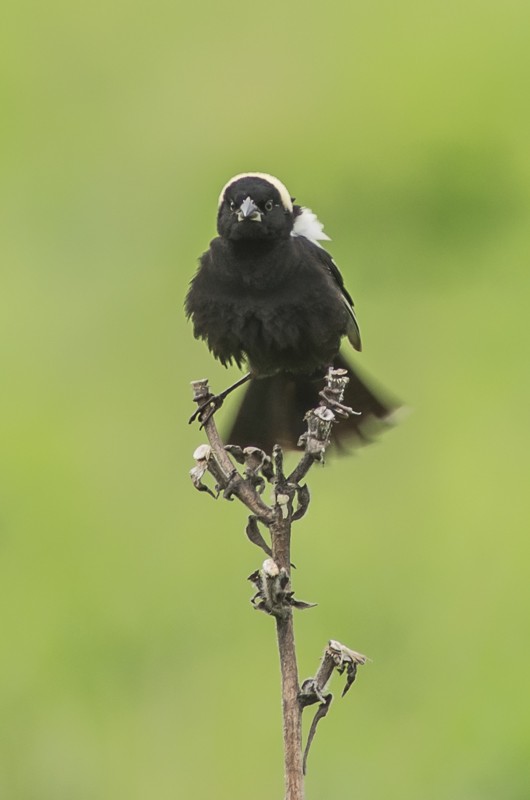Bobolink
A species of Bobolinks Scientific name : Dolichonyx oryzivorus Genus : Bobolinks
Bobolink, A species of Bobolinks
Botanical name: Dolichonyx oryzivorus
Genus: Bobolinks
Content
Description People often ask General Info
Description
The bobolink is a delightful bird with a fun-loving spirit and distinctive black and white feathers. It sings a joyful, effervescent melody that fills fields and meadows with its merry sound. This bird makes a long journey each year between the Americas, adding to its intriguing nature. 
Size
16-20 cm (6.25-8 in)
Life Expectancy
9 years
Nest Placement
Ground
Clutch Size
3 - 7 eggs
Incubation Period
1 - 2 broods
Number of Broods
11 - 14 days
Nestling Period
10 - 11 days
Feeding Habits
Bobolink's diet consists of weed seeds, insect larvae, adult insects, spiders, and arachnids during the breeding season, feeding exclusively on invertebrates to their young. Foraging occurs at the tops of plants and near the ground for seeds and insects. They consume rice, oats, grains, and insects during migration and winter, sometimes nocturnally.
Habitat
Bobolink's habitat encompasses open grasslands rich in grasses and forbs, primarily in the northern United States and southern Canada. They breed in hayfields and meadows, and with forest retreat, they've also expanded into irrigated lands west of the Great Plains. Post-breeding habitats include freshwater marshes and coastal molting areas. In winter, bobolink migrates to South America's grasslands, marshes, and agricultural fields, avoiding forests and urban zones.
Nest Behavior
The female bobolink builds the nest solo within 1-2 days, sometimes adding lining post egg-laying. Key nesting behaviors include selecting a site on the male's territory, using nearby materials, and meticulous nest construction.
Nest Characteristics
Bobolink's nest is located on wet ground, typically at the base of sturdy, nonwoody plants. Constructed by the female using grasses and weed stems, it features a floorless outer wall and a fine-grassed lining, measuring 2.4-4.3 inches across and up to 2 inches deep.
Dite type
Granivorous
People often ask
General Info
Feeding Habits
Bird food type
Bird Feeder Type

Platform
Behavior
Bobolink engage in a complex mating system that is both polygynous and polyandrous, leading to varied paternity within clutches. They exhibit strong territorial behavior during the breeding season, showcased through singing, displaying, and physical disputes. Both sexes share in feeding the young in the male’s primary nest, with potential help from additional adults in secondary nests. Post-nesting, bobolink live in social flocks, transition from parental dependence to foraging proficiency within a month, and depart from breeding grounds in groups.
Distribution Area
The bobolink breeds in the summer in North America across much of southern Canada and the northern United States. It migrates long distances, wintering in southern South America in Argentina, Bolivia, Brazil and Paraguay. One bird was tracked migrating 12,000 mi (19,000 km) over the course of the year, often flying long distances up to 1,100 mi (1,800 km) in a single day, then stopping to recuperate for days or weeks. They often migrate in flocks, feeding on cultivated grains and rice, which leads to them being considered a pest by farmers in some areas. Although bobolinks migrate long distances, they have rarely been sighted in Europe—like many vagrants from the Americas, the overwhelming majority of records are from the British Isles. The species has been known in the southern United States as the "reedbird," or the "ricebird" from their consumption of large amounts of the grain from rice fields in South Carolina and the Gulf States during their southward migration in the fall. One of the species' main migration routes is through Jamaica, where they are called "butter-birds" and at least historically were collected as food, having fattened up on the aforementioned rice. 
Species Status
The numbers of these birds are declining due to loss of habitat. Bobolinks are a species at risk in Nova Scotia, and throughout Canada. In Vermont, a 75% decline was noted between 1966 and 2007. Originally, they were found in tall grass prairie and other open areas with dense grass. Although hay fields are suitable nesting habitat, fields which are harvested early, or at multiple times, in a season may not allow sufficient time for young birds to fledge. Delaying hay harvests by just 1.5 weeks can improve bobolink survival by 20%. This species increased in numbers when horses were the primary mode of transportation, requiring larger supplies of hay. 
